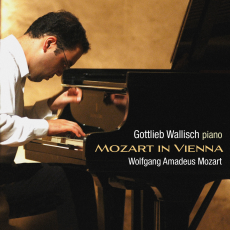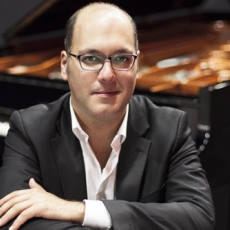Gottlieb Wallisch - Mozart in Vienna - Fanfare
Thirty-two-year-old Gottlieb Wallisch was born in Vienna in 1978, graduated with honors from the Vienna University of Music and Drama, participated in master classes given by Stephen Kovacevich and Claude Frank, has won numerous awards, appeared as soloist with leading orchestras and conductors, and has recorded a number of albums, to date mostly for Naxos. Susan Kagan said of Wallisch's Schubert CD in 31:4, "The warmth in his playing complements Schubert's poignant and expressive writing, while his sparkling touch brings lightness and gracefulness to livelier movements." Though Susan found no mention of a continuing Schubert cycle from Wallisch, if ArkivMusic's published release dates are to be trusted, it appears that two other discs in a Wallisch Schubert cycle actually predate the one Susan reviewed. I might also mention a cpo recording by Wallisch of a piano concerto by Eric Zeisl, a composer I did not know personally, but whose niece was a neighbor when I was in college. That CD was reviewed by our own Lens F. Laurson before he joined the Fanfare family. His review can be found under Zeisl at ArkivMusic.
Wallisch's current Linn CD carries the seemingly expendable title, "Mozart in Vienna." All of the pieces on the disc were written after 1781, which is when the composer took up permanent residence in the city. His mature piano sonatas (Nos. 10 through 18) and most of his fantasies, rondos, and variations for solo piano were produced during his last 10 years in the Austrian capital, so "Mozart not in Vienna" would be a title to pique curiosity. This is by way of saying that Wallisch has chosen for his first Mozart album five of the composer's most popular and most frequently recorded works. Taking them chronologically, they are the D-Minor Fantasy (1782), the Variations on "Unser dummer Pöbel meint" (1784), the A-Minor Rondo (1787), and the two final sonatas (1789).
The Fantasy is one of Mozart's more enigmatic creations. In just under six minutes, it manages to change tempos several times and spans quite a range of expressive states. The piece was left unfinished by some number of bars, the original manuscript has been lost, and the abrupt concluding chords are believed to have been added by August Eberhard Müller, a friend and admirer of the composer. Despite the freeform style of its writing (obviously, there's a reason Mozart called it a "fantasy"), the piece does divide into roughly two equal halves, the first, slow in pace and in D-Minor, the second, quick-paced and in D-Major, thus giving us loosely the equivalent of an A-B form.
The "Unser dummer Pöbel meint" theme upon which Mozart based his Variations comes from Gluck's French comic opera La Rencontre imprévue, which was first performed in Paris in 1764. The opera enjoyed great success, being adapted in a German version under the title Die Pilgrime von Mekka in the 1770s. Mozart gave the first performance of the Variations at the Burgtheater on March 23, 1783, in a program that included the "Haffner" Symphony and his latest piano concerto, the No. 13 in C-Major, K 415. Gluck's theme, like that of another of the composer's popular variations works on the tune "Ah vous dirai-je maman" (so well known to us as "Twinkle, Twinkle Little Star") is perfectly suited to the "divisions" type of variations treatment, which is to say it's harmonically simple, rhythmically regular, and melodically trite. What Mozart does with it of course is none of the above but rather quite sophisticated.
If any piece by Mozart can be said to foreshadow Chopin, the A-Minor Rondo would be a good candidate, at least in its opening strains. An atmosphere of gloom, even foreboding, seems to permeate the piece, and it's never entirely dispelled despite intervening episodes of a lighter character in the major key. Wallisch, in his program note, calls it "an intimate piece of chamber music for solo piano, full of melancholy, poetry, and confession."
Although Mozart's last two piano sonatas both date from the same year (1789), they're actually quite dissimilar. Unusual for Mozart, the first movement of the BI-Major Sonata (No. 17) is a monothematic sonata-allegro form-i.e., the piece modulates, as expected, from the tonic to the dominant for the second theme, but the second theme is identical to the first. I must take exception here to Wallisch's claim that dramatic contrast is thereby eliminated. The operative dynamic that drives sonata-allegro form, which I'm sure he knows, is harmonic, not thematic. The drama comes from the conflict between keys, not themes. Thematic contrast becomes a more prominent feature from Beethoven onward, and part of Romanticism's masculine vs. feminine paradigm. But its presence or absence is immaterial to the functioning of the form, which is dependent on the dramatic tension of opposing tonics in the exposition and their reconciliation in the recapitulation. But I digress.
The BI-Major Sonata seems pared down in ways other than thematic thrift. The writing is more economical and concentrated-one might even say bare-bones-compared to the more florid, public-pleasing virtuosic style Mozart adopts in some of his earlier sonatas. The sparse harmony and contemplative mood of the Adagio further reinforce the impression of the composer turning inward. Even the concluding Allegretto doesn't frolic with quite the same rollicking gaiety of the opera finales that characterizes so many of Mozart's piano concerto and earlier sonata finales.
The D-Major Sonata (No. 18), which turned out to be the composer's last piano sonata, also, ironically, turned out to be one of his most technically challenging, ironic because it was to have been the first of six "easy" sonatas he was intending to write for the Princess Friederike. Either she was a lot more accomplished at the keyboard than we think, or Mozart simply forgot who the intended recipient was and the purpose of the piece. According to Wallisch, "Commanding the technical difficulties without losing a light and playful sound is a challenging task in itself, but even more daunting is mastering its polyphonic style."
Finally, speaking of mastering challenges, we come to Wallisch who does so with amazing aplomb. The pianist delivers one of the most engaging and satisfying Mozart recitals I've heard in a long time. Getting Mozart just right requires a delicate balance between lightness of touch and depth of tone, between sustained cantabile legato and pert rhythmic buoyancy, and not infrequently all at the same time. Add to that the interpretive skill and wisdom necessary to plumb the profound feelings that lie at the core of a music that can sometimes sound superficially trivial, and you have in Mozart perhaps the most difficult of all composers to bring off. Gottlieb Wallisch, I believe, possesses all of these attributes. His playing is a thing of rare beauty and a joy to behold. His Steinway grand is superbly captured in Bristol, England's St. George's Church and reproduced magnificently by Linn's recording. This is a must for all Mozart mavens.

